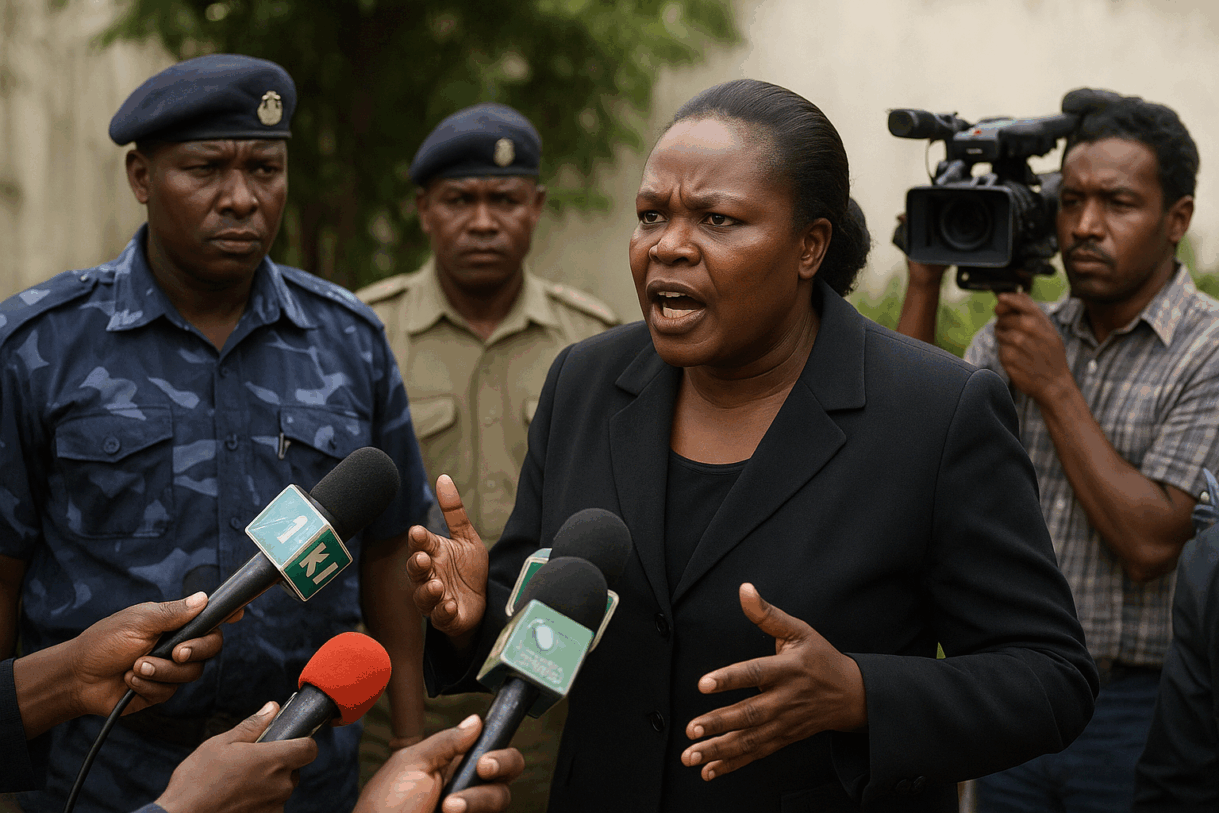
simply amazing, always for you.
Part I: Rise, Power, and the Making of a Storm
Introduction: A First Lady Unlike Any Other
In the political annals of Kenya, few public figures have generated as much fascination, debate, and controversy as Lucy Muthoni Kibaki. Serving as First Lady from 2002 to 2013 during the presidency of Mwai Kibaki, Lucy was a paradoxical figure: fiercely protective yet often confrontational, intensely private yet prone to very public outbursts. In a political culture where First Ladies were traditionally expected to remain in the background, smiling benignly beside their husbands, Lucy Kibaki shattered convention — and in doing so, redefined the role in ways that continue to shape public discourse in Kenya today.

Her tenure was marked by incidents that ranged from the bizarre to the dramatic: storming media houses in the middle of the night, slapping a journalist on live camera, confronting senior politicians in State House, and forcing a sitting president to hold a press conference about his private life. Each of these moments became a national talking point, dominating headlines, inspiring satire, and igniting heated debates on the limits of power, gender expectations, media freedom, and the personal lives of public officials.
Yet behind the spectacle was a complex figure — a woman shaped by a deeply patriarchal society, a fiercely loyal protector of her family, and a symbol of how Kenya’s evolving democracy often collided with entrenched traditions. Lucy Kibaki was, at once, a reflection of Kenya’s shifting political culture and an agent of disruption within it.
Early Life and Path to the Presidency
Lucy Muthoni Kagai was born in 1940 in Mukurweini, Nyeri County, during the tail end of British colonial rule in Kenya. The daughter of Rev. John Kagai, a respected clergyman in the Church of Scotland Mission, and Rose Nyachomba, Lucy grew up in a strict Christian household that prized discipline, education, and moral rectitude. Her upbringing instilled in her a deep sense of authority and conviction — traits that would later define her public life.
After attending Alliance Girls’ High School, one of the country’s most prestigious institutions for women, Lucy pursued a career in education. She trained as a teacher and later served as a principal, a role that honed her leadership skills and assertive personality. It was during this period that she met Mwai Kibaki, then an economics lecturer and rising figure within Kenya’s independence-era political elite.
The two married in 1962, a union that would span more than five decades. As Kibaki rose through the political ranks — serving as a Member of Parliament, Minister for Finance, Vice President, and eventually President — Lucy remained largely in the background. Unlike some political spouses, she avoided the limelight during these years, dedicating herself to raising their four children and supporting her husband’s career from behind the scenes.
Redefining the Role of First Lady
When Mwai Kibaki won the presidency in December 2002, ending Daniel arap Moi’s 24-year rule, Kenya entered a new political era — one defined by heightened expectations of transparency, democratic accountability, and reform. It was also the beginning of Lucy Kibaki’s transformation from a private citizen into one of the most scrutinized figures in Kenyan public life.
Traditionally, Kenyan First Ladies had been expected to play ceremonial roles — presiding over charity events, hosting dignitaries, and speaking sparingly in public. Lucy, however, rejected this script. She brought to State House the same assertive energy that had defined her personal life. In speeches, she spoke bluntly about corruption, morality, and the responsibilities of leadership. She insisted on being treated with the respect she felt the office deserved and was unafraid to confront those — journalists, politicians, even foreign diplomats — whom she believed had crossed the line.
While some Kenyans admired her strong will and forthrightness, others saw her behavior as unbecoming of a First Lady. It was in this tension between traditional expectations and her own unapologetic personality that much of Lucy Kibaki’s public drama would unfold.

Early Signs of a Storm: Media Confrontations and Public Outbursts
The first major indication that Lucy Kibaki would not conform to conventional expectations came in 2003, barely a year into her husband’s presidency. Upset by loud music emanating from a party at the residence of then-Environment Minister Newton Kulundu, Lucy reportedly stormed the gathering late at night to demand that the music be turned off. Witnesses recalled that she was visibly angry and that the incident created considerable embarrassment for the government.
But the most infamous incident — and the one that cemented her reputation as a combative First Lady — occurred in May 2005. Furious about what she considered unfair media coverage of her family, Lucy Kibaki arrived unannounced at the offices of Nation Media Group in Nairobi around midnight, accompanied by security officers. She was angry over an article that had described her as having caused a disturbance at a diplomatic function.
Inside the newsroom, chaos ensued. Lucy demanded to see editors and senior managers, berating them for what she called “disrespectful” reporting. As journalists watched in disbelief, she slapped photojournalist Clifford Derrick, who had attempted to film the encounter. The following morning, the incident dominated national headlines.
“This was unprecedented,” said media analyst David Makali in an interview at the time. “Never before had a First Lady physically entered a newsroom to challenge editorial content — let alone assaulted a journalist. It raised profound questions about press freedom and the independence of the media in a democratic society.”
The Polygamy Allegations and the State House Press Conference
Perhaps the most dramatic episode of Lucy Kibaki’s tenure as First Lady — and one that offered a rare glimpse into the private life of the presidency — unfolded in 2009 amid persistent rumours that President Kibaki had a second wife, businesswoman Mary Wambui. Though Kibaki had long denied the reports, they continued to circulate, fueled by media speculation and Wambui’s own public appearances.
For Lucy, the rumours were more than gossip — they were an affront to her dignity and a threat to her family’s public image. In a rare move, she is said to have pressured the president to address the matter publicly. The result was one of the most surreal press conferences in Kenyan political history.
Standing beside Lucy at State House, President Kibaki declared emphatically: “I want to make it very clear that I have only one wife. Her name is Lucy Kibaki. Any other woman who claims to be my wife is an impostor.”
Lucy, standing silently but visibly agitated, nodded as her husband spoke. The image — of a sitting president forced to publicly affirm his marital status — was both unprecedented and politically explosive. It underscored Lucy’s influence within State House and her determination to defend her position as First Lady.
“This was not just about marriage,” noted political commentator Njeri Rugene. “It was about power, legitimacy, and control over the narrative. Lucy Kibaki was not going to allow anyone — not the press, not another woman — to define her place in Kenya’s political hierarchy.”
Gender, Power, and Media Portrayal
Lucy Kibaki’s confrontations with the press and her public defense of her family highlighted deeper tensions in Kenyan society — particularly around gender and power. In a political culture where powerful men often acted with impunity while their spouses remained silent, Lucy’s outspokenness was seen as both radical and unsettling.
Critics described her as “volatile,” “unruly,” and “undignified,” arguing that her behavior undermined the dignity of the presidency. Supporters, however, saw a woman who refused to be silenced or humiliated — a figure who challenged Kenya’s deeply ingrained expectations of how women in power should behave.
“The media often portrayed her as hysterical,” wrote columnist Philip Ochieng in the Sunday Nation. “But what we were witnessing was a woman asserting agency in a space traditionally reserved for men. Lucy Kibaki was never content to be a decorative presence.”
The Clash at State House: Gitobu Imanyara Incident
One of the most controversial and least understood episodes of Lucy Kibaki’s tenure occurred in 2007, when an altercation reportedly took place between her and Gitobu Imanyara, a prominent lawyer and Member of Parliament. According to media reports and Imanyara’s own later account, the confrontation occurred at State House during a meeting over a constitutional issue. Tensions escalated, and Lucy allegedly confronted Imanyara physically — prompting him, by his own admission, to slap her in self-defense.
The incident, though never fully corroborated by State House, became the subject of intense public debate. It further fueled Lucy’s reputation as combative and unrestrained, while also raising questions about decorum, power dynamics, and the personal conduct of Kenya’s political elite.
Part II: Legacy, Influence, and the Complex Afterlife of Controversy
Retreat from the Spotlight: The Silent Years
By the early 2010s, Lucy Kibaki’s once-ubiquitous public presence began to fade. The fiery outbursts and late-night media raids that had defined her earlier years as First Lady grew less frequent, and appearances alongside President Mwai Kibaki became increasingly rare. Rumours swirled in political and media circles that her health was deteriorating — speculation that was never publicly confirmed but widely believed to be true.
Observers noted that the First Lady’s withdrawal from public life coincided with a period of political transition in Kenya. The country was grappling with the aftermath of the 2007–2008 post-election violence, the birth of a new constitutional order in 2010, and the complex negotiations of coalition politics. Amid these seismic shifts, Lucy’s influence seemed to wane — but her legacy, for better or worse, was already deeply entrenched in the public imagination.
“She disappeared from the limelight, but not from memory,” remarked political scientist Prof. Karuti Kanyinga. “Lucy Kibaki had already made her mark. Whether one viewed her as a disruptive force or a trailblazer, she had changed the nature of the First Lady’s office forever.”
Legacy of Confrontation: How Lucy Changed the Media Landscape
No aspect of Lucy Kibaki’s public life generated more controversy — or left a deeper mark — than her fraught relationship with the press. Her confrontations with journalists, editors, and media houses raised profound questions about freedom of expression, the limits of executive power, and the role of the First Lady in a democratic society.
Kenya’s media landscape in the early 2000s was evolving rapidly. The end of the Moi era ushered in a new era of press freedom, with journalists exercising newfound independence and investigative reporting becoming increasingly common. Lucy’s combative stance toward the media, therefore, was not merely a personal quirk — it was part of a larger political struggle over control of the narrative.
Her 2005 invasion of the Nation Media Group newsroom, for example, was widely condemned by press freedom advocates. The Kenya Union of Journalists (KUJ) described it as “an unacceptable assault on the Fourth Estate,” while The Standard ran a blistering editorial declaring, “The First Lady’s behaviour is a stark reminder that freedom must always be defended — even from those closest to power.”
Yet the incident also had unintended consequences. By overstepping boundaries so visibly, Lucy arguably strengthened the resolve of the press. Media houses became more assertive in defending their independence, journalists grew bolder in their coverage of state affairs, and public debate around press freedom intensified.
“Lucy Kibaki’s clashes with the media were paradoxical,” observed veteran journalist Macharia Gaitho. “On the one hand, they were a direct challenge to journalistic autonomy. On the other, they galvanized the profession and reminded the public of the media’s watchdog role. In that sense, she may have done more to advance press freedom than she intended.”
The Gender Question: Redefining Expectations of Political Spouses
Perhaps Lucy Kibaki’s most significant — and least understood — impact lies in the realm of gender politics. In a society where women in positions of power were often expected to be soft-spoken, deferential, and apolitical, Lucy defied every stereotype. She was outspoken, aggressive, unapologetic, and fiercely protective of her space. To many, she was a breath of fresh air — a symbol of female agency in the heart of a patriarchal political system.
But that same assertiveness also made her a target of intense criticism. Media narratives frequently described her as “temperamental,” “volatile,” and “irrational” — adjectives rarely applied to male leaders who displayed similar behaviour. Feminist scholars argue that this gendered language revealed deep-seated biases in how society perceives powerful women.
“Lucy Kibaki was judged by a different standard,” wrote gender studies professor Dr. Wanjiru Kamau in a 2012 journal article. “Her assertiveness was pathologized in ways that male politicians’ aggression never was. The controversy surrounding her conduct reflects Kenya’s broader discomfort with women who refuse to conform to traditional roles.”
Lucy’s legacy also paved the way — however controversially — for future First Ladies to engage more actively in public life. Margaret Kenyatta, who succeeded her as First Lady in 2013, pursued a more measured approach but remained far more visible and influential than most of her predecessors. Similarly, Rachel Ruto, the current First Lady, has positioned herself as a political actor in her own right, leading faith-based initiatives and appearing frequently at public events.
“Lucy Kibaki kicked the door open — perhaps too forcefully — but she opened it nonetheless,” noted political commentator Mutahi Ngunyi. “Future First Ladies operate in a space that she helped create.”
Marriage, Power, and the Private Made Public
The 2009 press conference in which President Kibaki was compelled to publicly declare that he had only one wife was one of the most extraordinary moments in Kenya’s political history. It marked a rare intrusion of personal life into the public sphere and underscored the complex interplay between marriage, power, and legitimacy in Kenyan politics.
For Lucy, the event was a deeply personal act of reclamation — an attempt to assert her rightful place and dispel narratives that threatened her dignity. But for the public, it was a revealing glimpse into the power dynamics of the presidency. It demonstrated the extent of Lucy’s influence and the degree to which private matters could shape political realities.
“This was not simply a domestic dispute,” said constitutional lawyer Dr. Kibe Mungai. “It was a moment that blurred the line between the personal and the political. Lucy Kibaki forced the state apparatus to serve a deeply personal purpose — and in doing so, she exposed the human side of power.”
The episode also highlighted a broader cultural tension in Kenya — one between the traditional acceptance of polygamy and the modern expectations of monogamy, especially for national leaders. By forcing a public reckoning with the issue, Lucy inadvertently sparked conversations about gender roles, marriage norms, and the private expectations placed on public figures.
The Decline: Health, Privacy, and Final Years
In the final years of President Kibaki’s administration, Lucy became an increasingly elusive figure. Public appearances grew rare, and speculation about her health intensified. By the time Kibaki left office in 2013, she had almost entirely vanished from public view.
Reports suggest that Lucy spent much of her later life receiving medical treatment abroad, though official statements remained vague. In April 2016, she passed away in London at the age of 76, reportedly due to complications related to an undisclosed illness.
Her death was met with a wave of tributes from across the political spectrum. Former Prime Minister Raila Odinga described her as “a formidable First Lady who spoke her mind and stood up for what she believed in.” President Uhuru Kenyatta lauded her as “a strong woman who contributed immensely to our nation’s development.” Even many of her critics acknowledged that, despite her controversies, she had left an indelible mark on the country.
The Long Shadow of Lucy Kibaki: Legacy and Historical Significance
Nearly a decade after her passing, Lucy Kibaki remains one of the most polarizing figures in Kenyan political history. Her legacy is complex, multifaceted, and deeply contested — but it is also undeniable. To understand her impact, it is necessary to consider the broader spheres she influenced:
1. Redefining the First Lady’s Role:
Lucy transformed the office of the First Lady from a ceremonial appendage into a platform of political influence. She demonstrated that the president’s spouse could shape narratives, challenge institutions, and command public attention in their own right.
2. Media Freedom and State Power:
Her clashes with journalists exposed the vulnerabilities and resilience of Kenya’s media. They served as both a warning about executive overreach and a catalyst for greater journalistic independence.
3. Gender Politics and Public Perception:
Lucy’s unapologetic assertiveness challenged societal norms around gender and leadership. She forced Kenya to confront its biases about women in power, even as those biases shaped how she was remembered.
4. Personal and Political Intersections:
Her insistence on addressing personal matters — such as allegations of polygamy — in the public arena underscored how personal relationships can shape political narratives and institutional legitimacy.
5. Legacy of Fear and Respect:
Even her harshest critics concede that Lucy commanded respect. For some, that respect was rooted in fear of her temper. For others, it stemmed from admiration for her courage to defy expectations and speak her truth — however unfiltered.
Final Reflections: A Mirror of a Nation in Transition
Lucy Kibaki’s story is not merely the tale of a controversial First Lady — it is a reflection of Kenya’s evolving democracy, its struggles with power and accountability, and its ongoing negotiation of gender roles in public life. Her life invites deeper questions about how societies perceive strong women, how far freedom of the press should extend, and how personal lives intersect with political realities.
She was, in many ways, a contradiction: a champion of family values who sometimes undermined public decorum; a defender of the presidency who occasionally embarrassed it; a private individual whose actions forced deeply personal issues into the public square. Yet it is precisely these contradictions that make her such a compelling historical figure.
In the end, Lucy Kibaki’s legacy cannot be neatly categorized as positive or negative. It is, instead, a mosaic of influence — a story of power wielded without apology, of norms broken and remade, of controversy that revealed deeper truths about Kenyan society. Her life reminds us that political history is not shaped only by presidents and policies, but also by the complex, often messy human beings who stand beside them.
Conclusion: An Untamed Legacy
Lucy Kibaki left behind a legacy that continues to spark debate, inspire analysis, and provoke reflection. She was neither saint nor villain, neither hero nor antagonist — but something far more interesting: a mirror through which Kenya could see its own evolving identity.
Her story endures because it speaks to universal tensions — between power and restraint, public and private, conformity and defiance. And it endures because it shows, with striking clarity, that even those not elected to office can wield enormous influence over a nation’s political and cultural trajectory.
In breaking the Mold of what a First Lady could be, Lucy Kibaki did more than redefine a role — she left a lasting imprint on Kenya’s political soul.
SUGGESTED READS
- Kenya at a Crossroads: Youth Protests, Economic Strain, and the Battle for Democracy
- Kenya in Focus: Key Trends and Events Shaping the Nation in 2025
- Future in Motion: How Global Trends Are Transforming Life in 2025 and Beyond
- How Kenya is Leading Africa’s Sustainable Future — From Renewable Energy to Zero-Waste Cities
- Youth and the 2027 Elections: How Young Voters Could Shape the Next General Election in Kenya

Support Our Website!
We appreciate your visit and hope you find our content valuable. If you’d like to support us further, please consider contributing through the TILL NUMBER: 9549825. Your support helps us keep delivering great content!
If you’d like to support Nabado from outside Kenya, we invite you to send your contributions through trusted third-party services such as Remitly, western union, SendWave, or WorldRemit. These platforms are reliable and convenient for international money transfers.
Please use the following details when sending your support:
Phone Number: +254701838999
Recipient Name: Peterson Getuma Okemwa
We sincerely appreciate your generosity and support. Thank you for being part of this journey!
